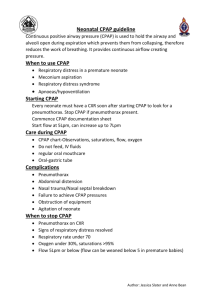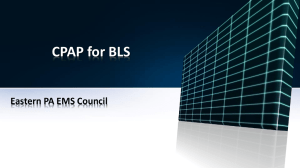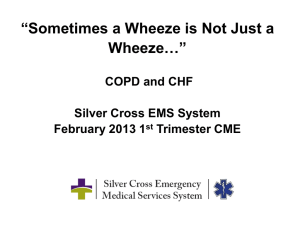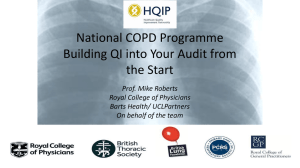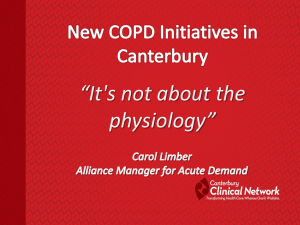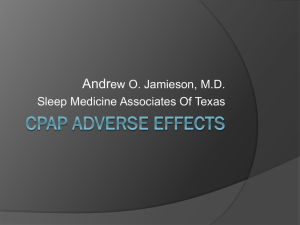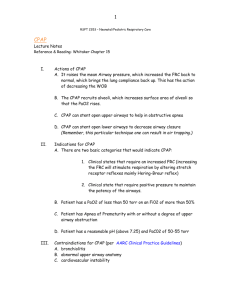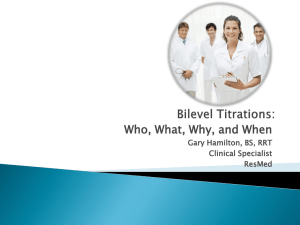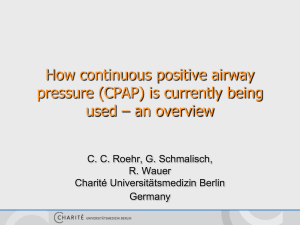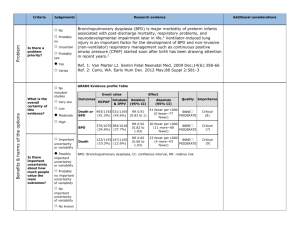CHF and CPAP - GMV Drug Bag
advertisement
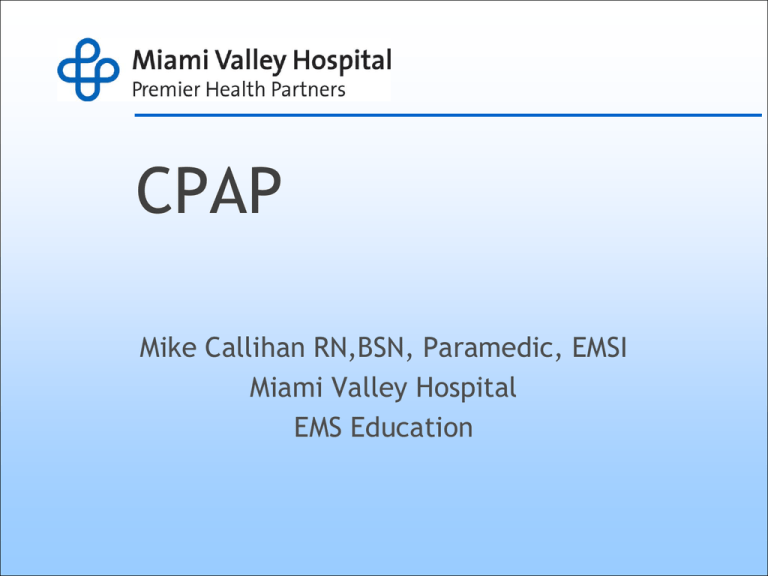
CPAP Mike Callihan RN,BSN, Paramedic, EMSI Miami Valley Hospital EMS Education Objectives • • • • • Define Congestive Heart Failure Define COPD Review standing orders for CHF and COPD Describe CPAP Practice usage of CPAP 2 A congested heart 3 Congestive Heart Failure • Congestive Heart Failure (CHF) is a serious disease associated with excessive morbidity and mortality and of elevated health-care costs. • Even with the advances in pharmacologic therapy, the mortality for the disease remains very high. 4 Congestive Heart Failure • Approximately 80% of patients with CHF showed restrictive spirometric pattern • Extravascular volume expansion and fluid accumulation in interstitial compartments of the lungs • Fluid accumulation is associated with increased heart size and reduced lung compliance. 5 Congestive Heart Failure • The accumulation of fluid leads to flooding of the alveoli resulting in a deficiency in gas exchange with several consequences, – Muscle weakness – Dyspnea with routine activities. – Dyspnea progresses into dyspnea at rest. 6 Bronchioles and Alveoli Oxygenated Blood to the Heart Pulmonary Venule Deoxygenated Blood from the Heart Bronchus Bronchiole Pulmonary Arteriole Alveoli Smallest Blood Vessels (Capillaries) 7 Pulmonary Edema Protocol • Assess for – – – – – – – – – – – Cyanosis clammy skin absence of fever coughing wheezing, labored breathing pitting edema rales in bilateral lower fields tachypnea apprehension JVD Inability to talk. 8 Treatment • If CPAP is available, its use is encouraged prior to initiation of drug therapy • If SBP>100, NTG 0.4 mg SL up to 3, 1 every 5minutes. Maintain SBP > 100 • Furosemide 80 mg slow IV push over 2 minutes. Maintain SBP >100 • Morphine, up to 5 mg, Slow IV over 2 minutes. Maintain SBP > 100. May repeat morphine, up to 5 mg, slow IV over 2 minutes. 9 Pulmonary Edema 10 COPD • COPD, or chronic obstructive pulmonary disease, is a progressive disease that makes it hard to breathe. • "Progressive" means the disease gets worse over time. • COPD can cause coughing that produces large amounts of mucus (a slimy substance), wheezing, shortness of breath, chest tightness, and other symptoms. 11 COPD • Airways and air sacs are elastic • In COPD, less air flows in and out of the airways because of one or more of the following: – The airways and air sacs lose their elastic quality. – The walls between many of the air sacs are destroyed. – The walls of the airways become thick and inflamed (swollen). – The airways make more mucus than usual, which tends to clog the airways. 12 COPD • COPD can cause: – coughing that produces large amounts of mucus, – wheezing – shortness of breath – chest tightness – other symptoms. 13 COPD causes • Cigarette smoking is the leading cause of COPD. Most people who have COPD smoke or used to smoke. • Long-term exposure to other lung irritants, such as air pollution, chemical fumes, or dust, also may contribute to COPD. 14 Asthma/Emphysema/COPD • Consider albuterol 2.5 mg and ipratropium 0.5 mg, nebulized with O2 8-12 LPM. • May repeat Albuterol 2.5 mg nebulized X 2. • COPD, CPAP or BiPAP • If patient arrests, tension pneumothorax is a likely cause • For asthmatics in severe distress: Epinephrine (1:1000) .3 mg SQ or autoinjector. • With Med control approval, may repeat Epinephrine. 15 So what is CPAP? 16 CPAP • Continuous positive airway pressure • CPAP is a tool to be used for assisting ventilation and should not be confused with trying correct Oxygenation concerns 17 Indications – Medical history and presenting complaints consistent with pulmonary edema – Patient must be 16 or older – COPD, Asthma – Bibasilar or diffuse rales – Near drowning – Disasters or mass casualties such as Bioterrorism with cases of respiratory distress 18 Contraindications • • • • • • • Respiratory or cardiac arrest Agonal respirations Severely depressed level of consciousness Systolic blood pressure < 90mmHg Signs and symptoms of pneumothorax Inability to maintain airway patency Major trauma, especially head injury with increased ICP or significant chest trauma • Facial Anomalies, e.g., burns, fractures • Vomiting • If patient deteriorates while on CPAP (O2 sats < 90), then prepare to intubate 19 Hazards of CPAP •Hypotension •Pneumothorax •Corneal Drying 20 Benefits to CPAP • The main direct benefits of CPAP are improved oxygenation, decreased respiratory effort, and decrease in left ventricular preload and afterload. • A recent study showed that with 2 weeks of CPAP usage for patients with CHF, pulmonary function was improved. 21 Goals of CPAP • Elimination of dyspnea • Reduced respiratory rate • Reduced heart rate • Increased SpO2 • Stabilized blood pressure 22 Important • Once a patient is started on CPAP, only remove treatment if the patient deteriorates or under medical control direction. • Call ahead to ER and inform them that patient is on CPAP, do not just unhook the patient and leave. 23 Summary • CPAP has been found to be as affective or more affective than the conventional pharmacological interventions. • CPAP is now being used as a part of GMVEMSC protocol 24
